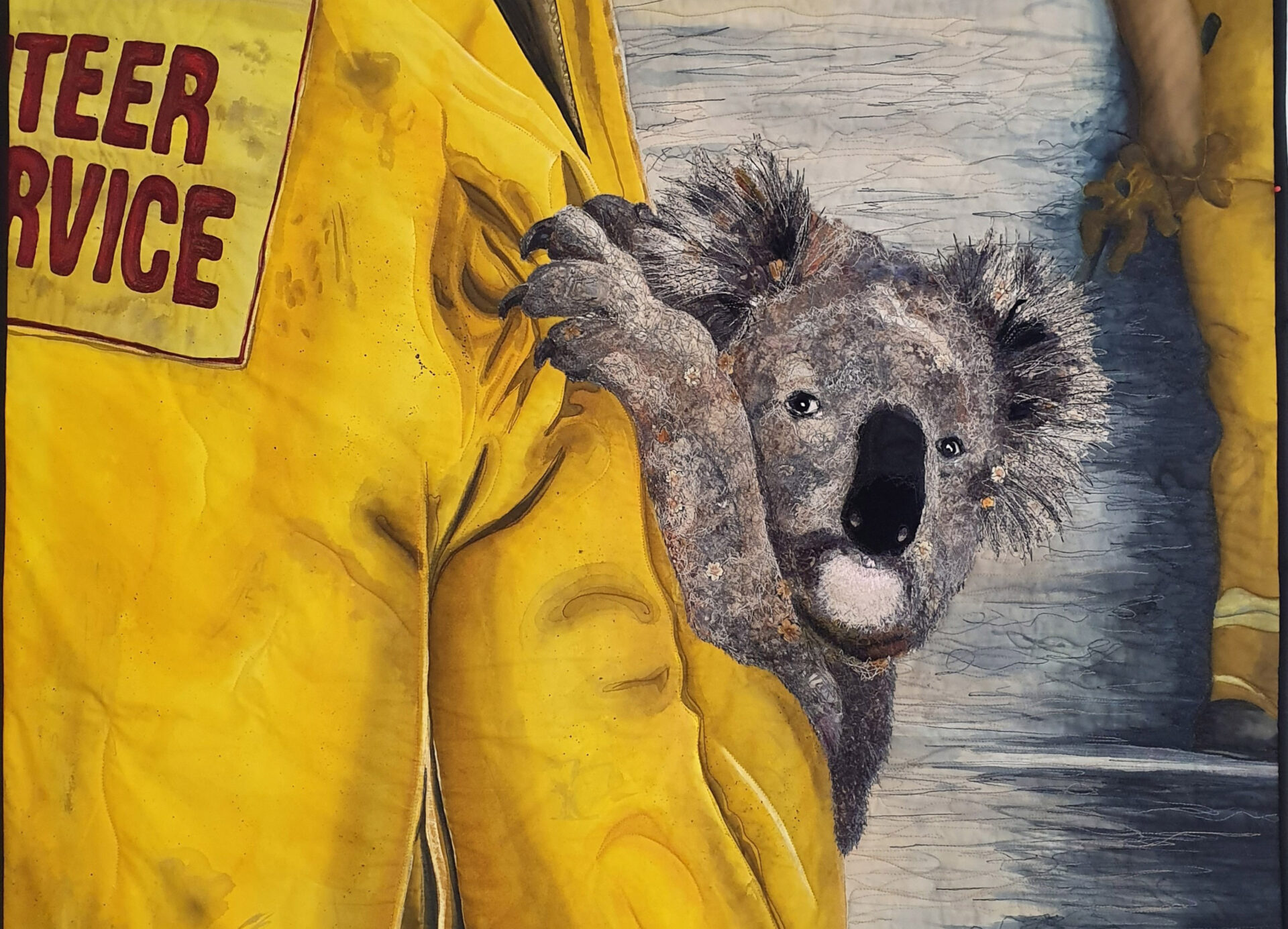
We Quilt This City: Peep These Quality Quilts
Quiltin’ ain’t easy, but those who give into its siren call can find it a hard habit to quilt – that is, quit. The quilting community contains a great deal of passion, creativity and warmth – both literally and figuratively – and nowhere are these qualities more on show than at the Australasian Quilt Convention (AQC). This year the AQC is rolling into Peppermint’s own stomping grounds. From 10am to 4.30pm, 26 to 29 May, these quilting queens will be setting up shop at the Brisbane Convention & Exhibition Centre and we couldn’t be more excited!
If you’ve got a deep abiding love of quilting, or even a passing interest in the textile arts, it’s well worth checking out. There will be workshops and classes with expert tutors, over 100 dedicated quilting retailers showcasing the latest gadgets, tools, fabrics and patterns – including Auto Alley where you can test drive the latest sewing machines – as well as exhibitions of the best quilts from around Australia and overseas!
We’re particularly looking forward to the ‘Going Green Challenge’, part of AQC’s annual quilting challenge where quilters are asked to create a work reflecting a chosen theme. This year’s delightfully environmental challenge sees the fabulous work of 30 of the finest finalists from Australia and New Zealand displayed. Winners will be announced at the convention’s Cocktail Party on Wednesday 25 May, but in the meantime, scroll through a few of our favourites below!
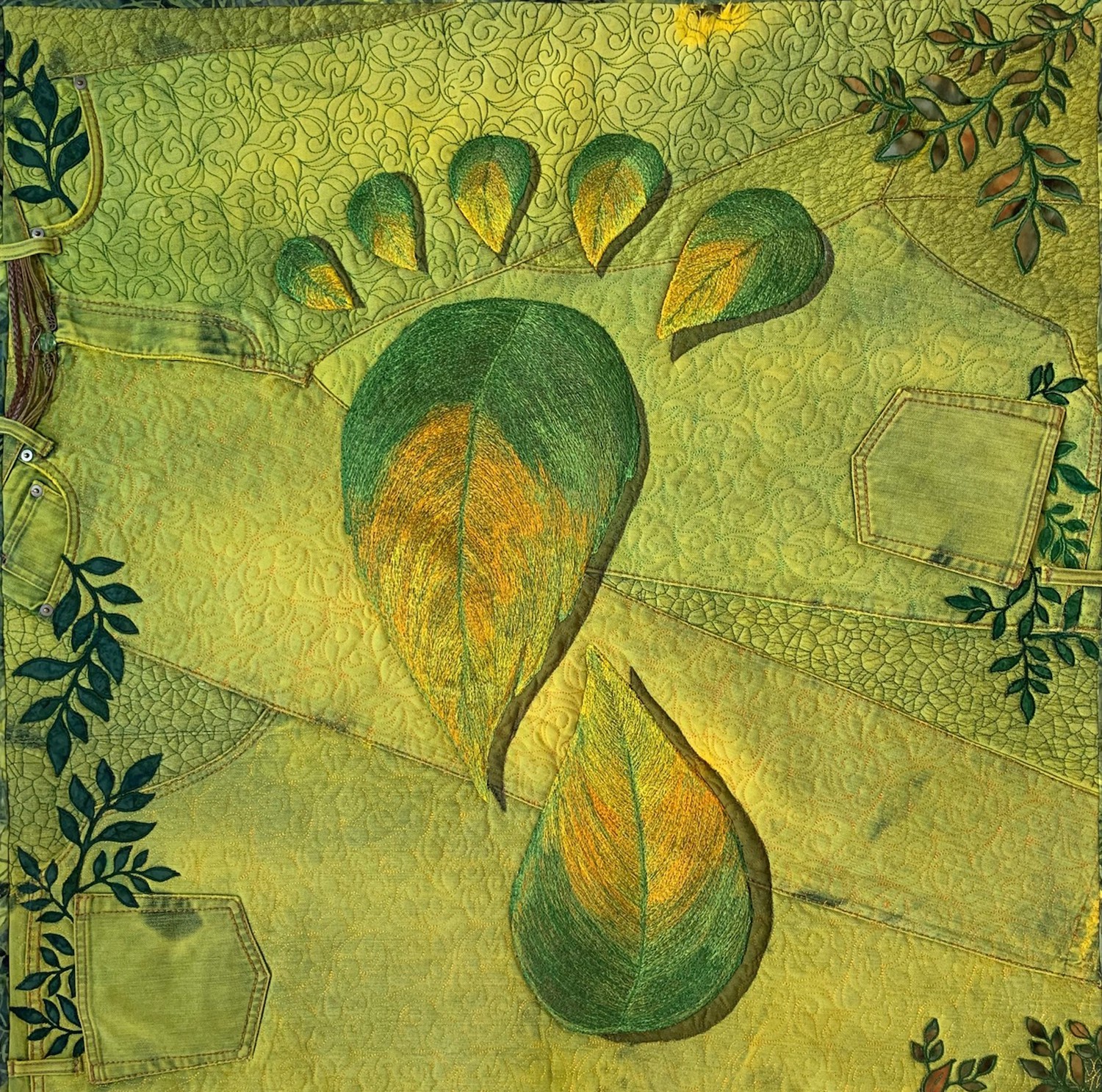
Nature’s Footprint
Lisa Alexander Malaga, Western Australia
There is a meaningful quote that I remember often, “Take only memories, leave only footprints.” I think this mantra goes hand-in-hand with the theme of ‘Going Green’. As we enjoy life on Earth, it is important that we remember to try to take less from our planet and aim to leave our Earth in a better place than when we arrived. By repurposing our used clothes, recycling our waste and being aware of our impact on the environment, we can all leave behind a greener footprint, and a footprint to be proud of…
Materials and techniques used: The quilt is made using repurposed jeans, dyed with eco-friendly dyes. Netting was used in some areas to give texture. Free-motion embroidery, free-motion applique and machine quilting.
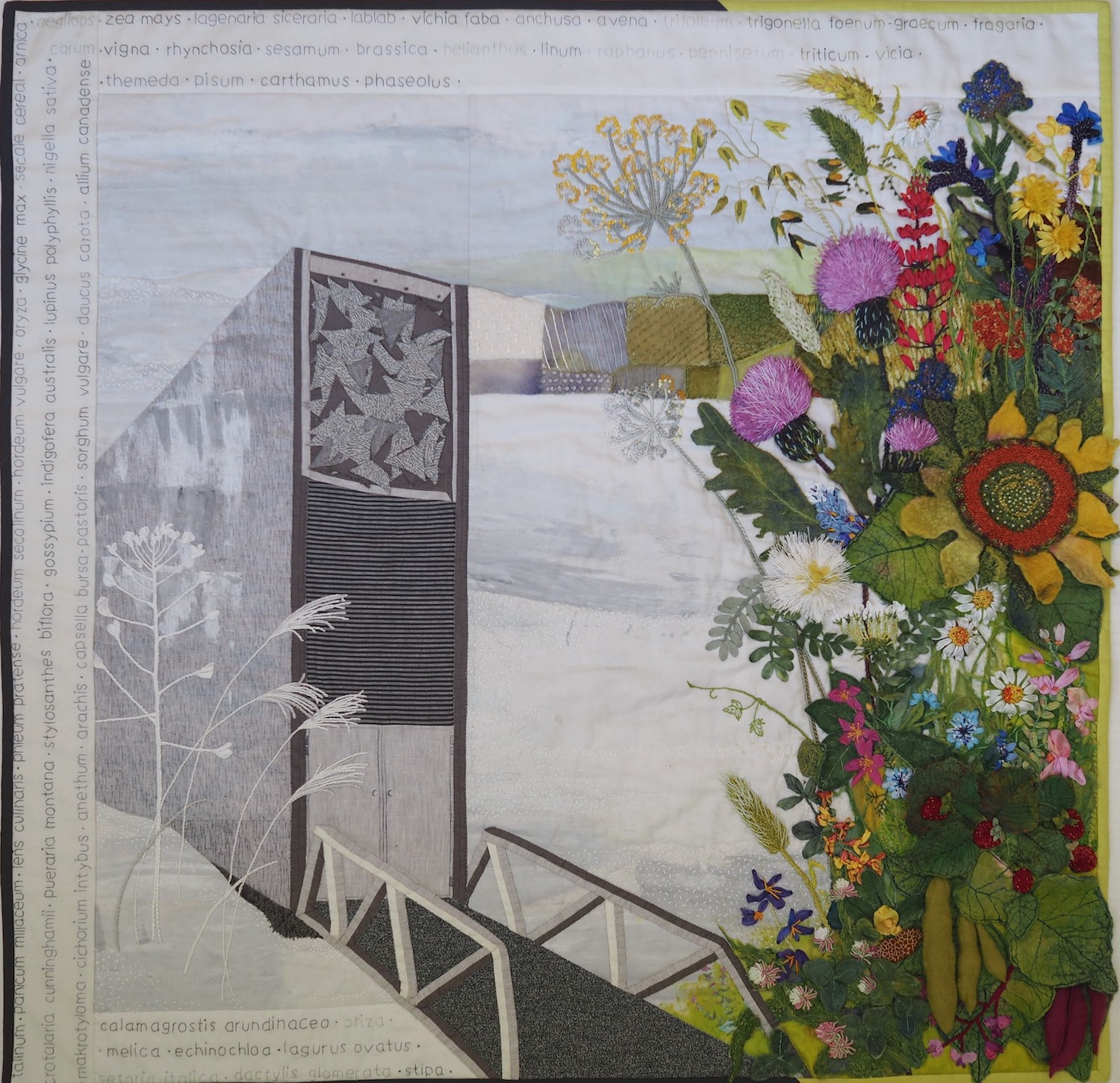
Going Green – When All Else Fails
Catherine Byatt, Wandin, Victoria
Svalbard Seed Vault, known as The Doomsday Vault, sits deep in the Norwegian permafrost, housing the world’s largest collection of seeds – a final insurance against crop failure due to man-made or natural disasters. Our quilt draws from the notion that “green” crops (food, feed, fibre, ornamental, industrial) may disappear (the GOING green). The cool white and grey of the solemn and isolated Svalbard, reflecting a ghostly Earth, post-calamity, is juxtaposed with the verdant potential of seeds, released to re-green the planet – transitioning from the monochrome palette (a world under threat of cataclysm) to green and bright (future survival for Earth’s inhabitants).
Materials and techniques used: Cotton, silk, wool, bamboo. Painting, bleaching, fused fabrics, applique, embroidery (flat, Brazilian, stumpwork, free-motion machine); felting (flat, nuno).
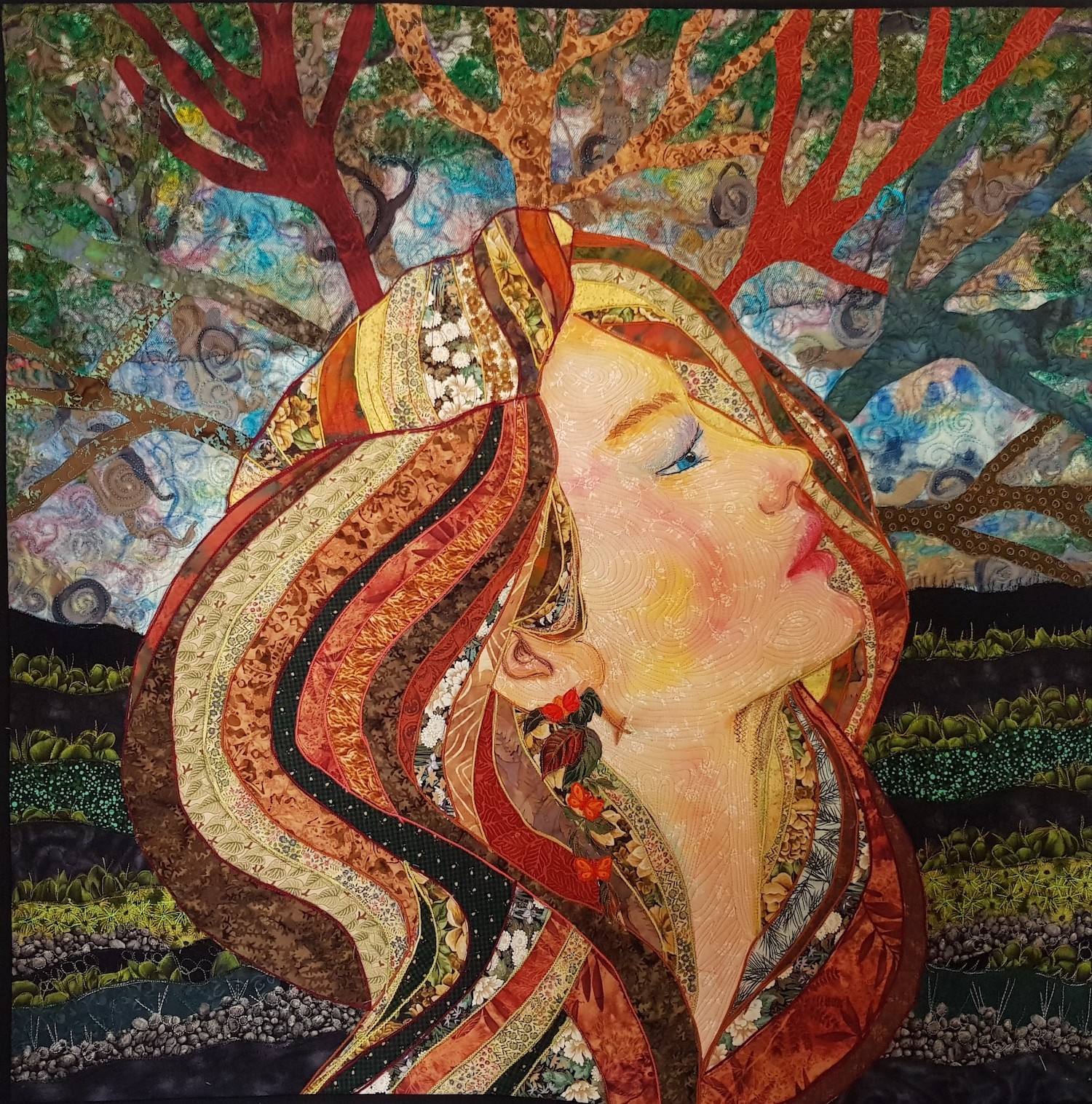
Cherish
Julie Evans, Lavington, New South Wales
Rebirth, renewal and regrowth are the words used to describe the re-greening of the land after a prolonged drought and lack of rain. Mother Earth looks after this planet and blesses it with beauty and abundance in spectacular shades of green. Our country is a land of contrasts and uniqueness and should be embraced by us all. We need to cherish what we have and preserve our gifts from Mother Earth. Only then can we continue going green.
Materials and techniques used: Painted fabric, felted areas under tulle, appliqued and heavily free-motion quilted.
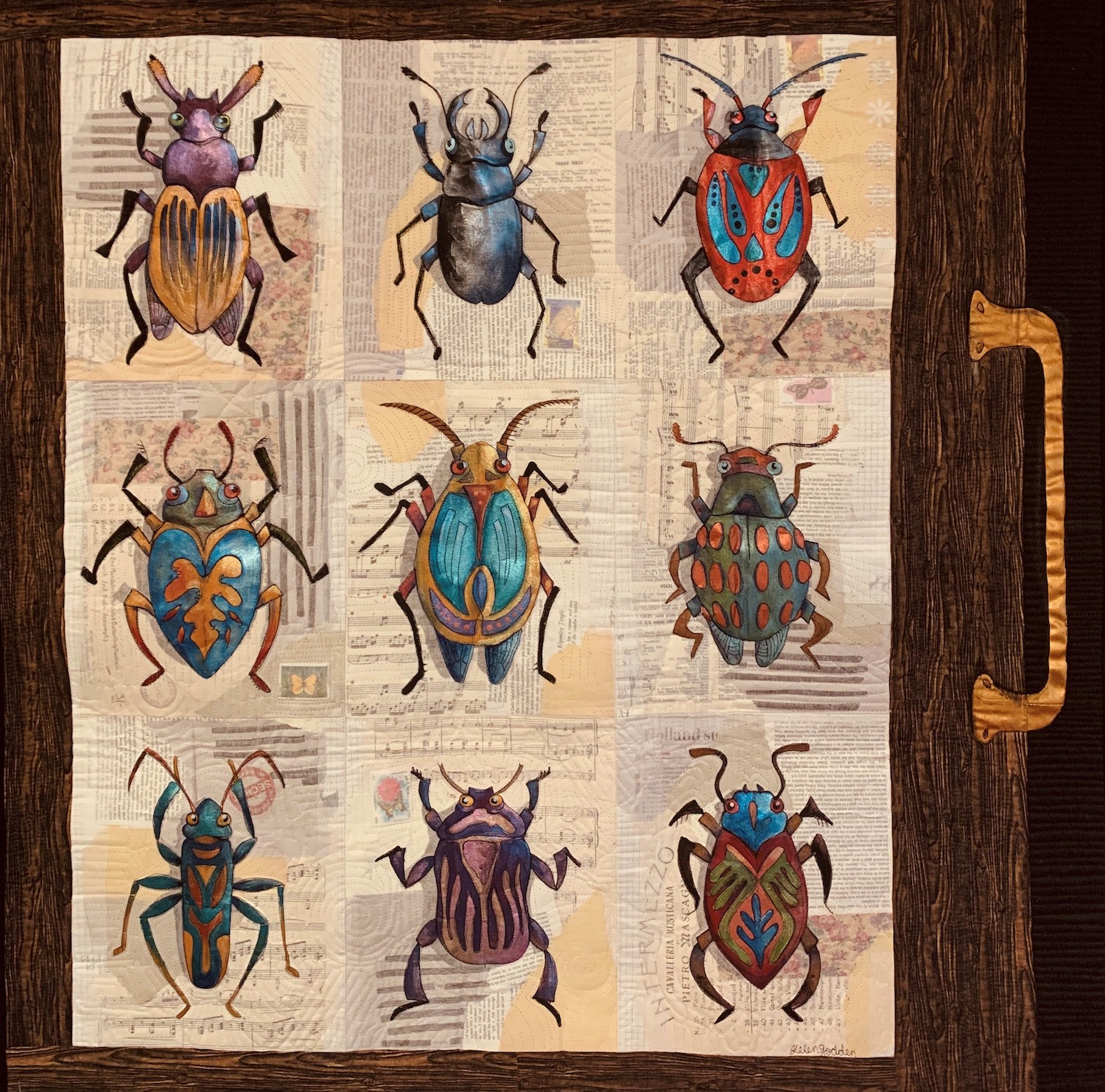
Beetles!
Helen Godden, Latham, Australian Capital Territory
From the big picture to the smallest detail, maintaining the delicate green balance of our amazing planet is paramount. Every creature – cute, cuddly, big or small – needs our attention. Did you know there are over 30 million species of beetles in this world and our environment needs them all to function?! If we don’t focus on the little things, the big things fall out of balance. We might not know their names, but in the future, some of these beetles could become just a memory, on display in a specimen drawer in a Museum of the Extinct!
Materials and techniques used: Repurposed pages from books and newspaper, lightweight interfacing, polyester batting, cotton backing, lumiere acrylic fabric paint, cotton thread.
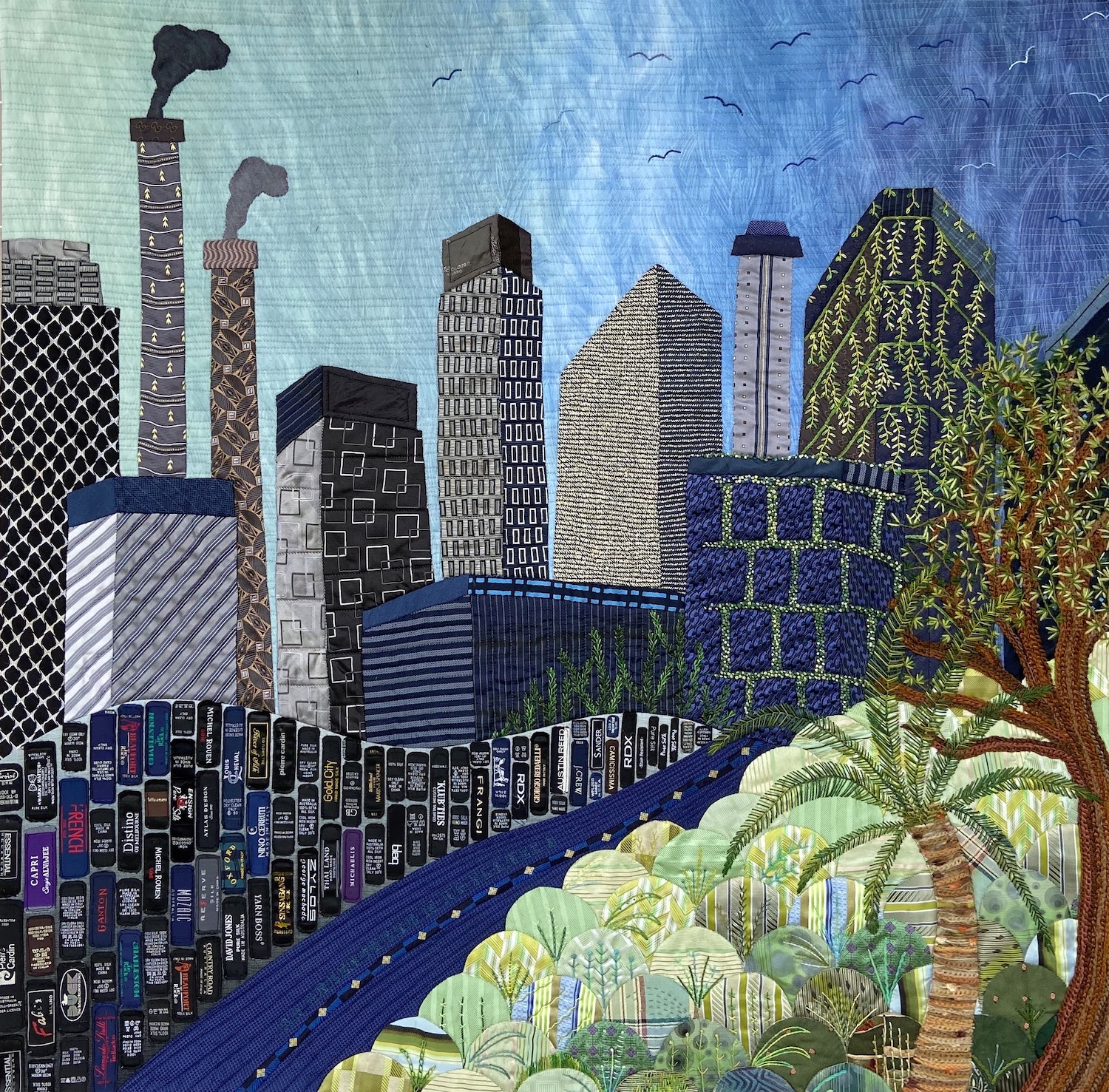
Time To Go Green
Nicky Haron, Pimpama, Queensland
Greening of our cities is a vital part of living more sustainably in order to secure the future of our planet. There is no Planet B. In keeping with the theme of ‘Going Green’, this quilt is made almost entirely of recycled fabrics found in op-shops. This includes silk ties, shirts, a scarf and an old flannel sheet (used as batting). The challenge for me was to use these unwanted, discarded items to make an interesting quilt with an important message for us all – there is no longer any doubt that it is ‘Time to Go Green’.
Materials and techniques used: Recycled fabrics including silk ties, shirts, a scarf, flannel sheet (used as batting), cotton, and a variety of threads including silk, cotton, rayon and wool. Hand applique, hand embroidery, machine piecing, machine quilting (domestic machine), machine embroidery (text).
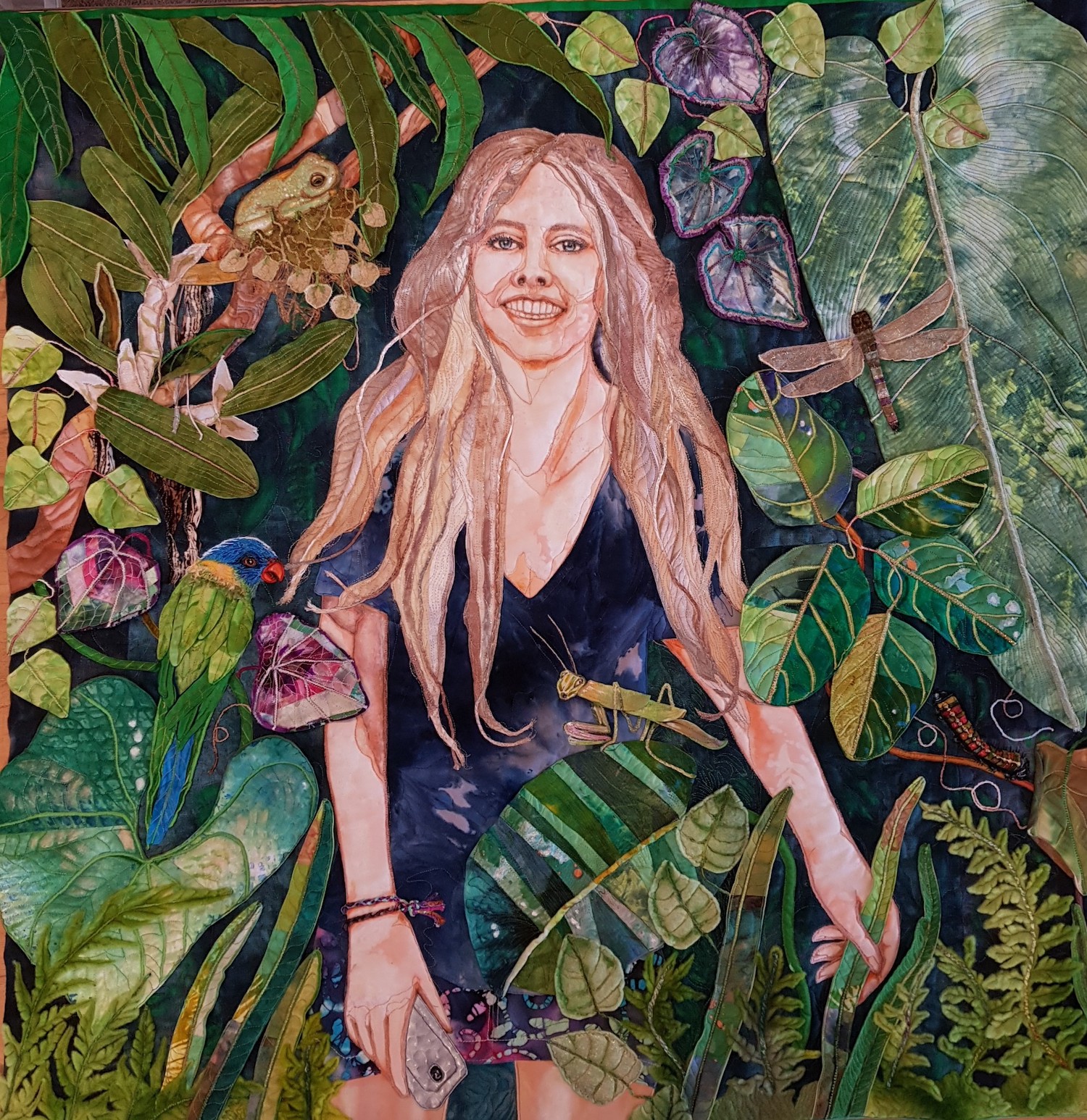
Go Offline, Go Into The Green
Jill Hessing, McKenzie Hill, Victoria
The real world, the green planet, needs saving. We need to remove ourselves from the artificial social and consumer construct we create for ourselves online. We need to see what really is valuable, and to do that, we need to go offline, out into the green. The green soothes our soul and reminds us of what is important.
Materials and techniques used: Hand-dyed American cross stitch linen, ice-dyed fabrics, recycled sari silk, hand-dyed ribbon and cord, free machine embroidery, permanent pen and fabric paint.
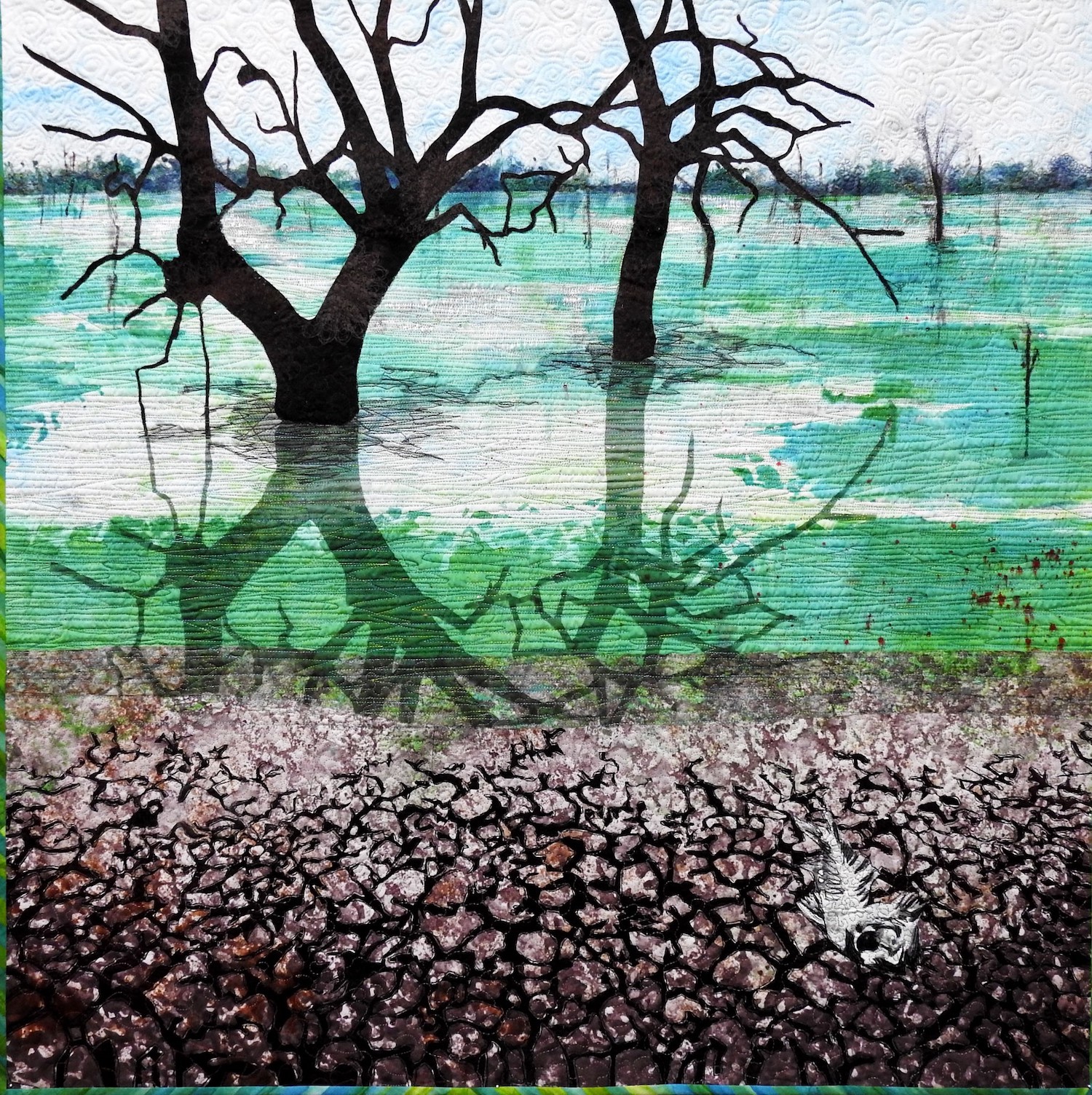
Blue-Green Algae
Linden Lancaster, Picola, Victoria
Blue-green algae are naturally occurring organisms that live in waterways. Under certain conditions they go crazy and reproduce expeditiously forming ‘toxic blooms’ that impact the environment. These conditions include excessive nutrients (often the result of fertiliser run-off) and hot, dry seasons. Decomposing algae brings a depletion of oxygen in the water, leading to fish kills, and makes the water hazardous to drink or come in contact with. Throughout Australia, the potential for blooms is increasing… a ‘Going Green’ not to be admired.
Materials and techniques used: Cotton fabrics, silk organza, tulle, polyester and metallic threads. Hand-painted and printed with thickened dyes, raw-edge applique, foiling, painting, free-motion stitching.
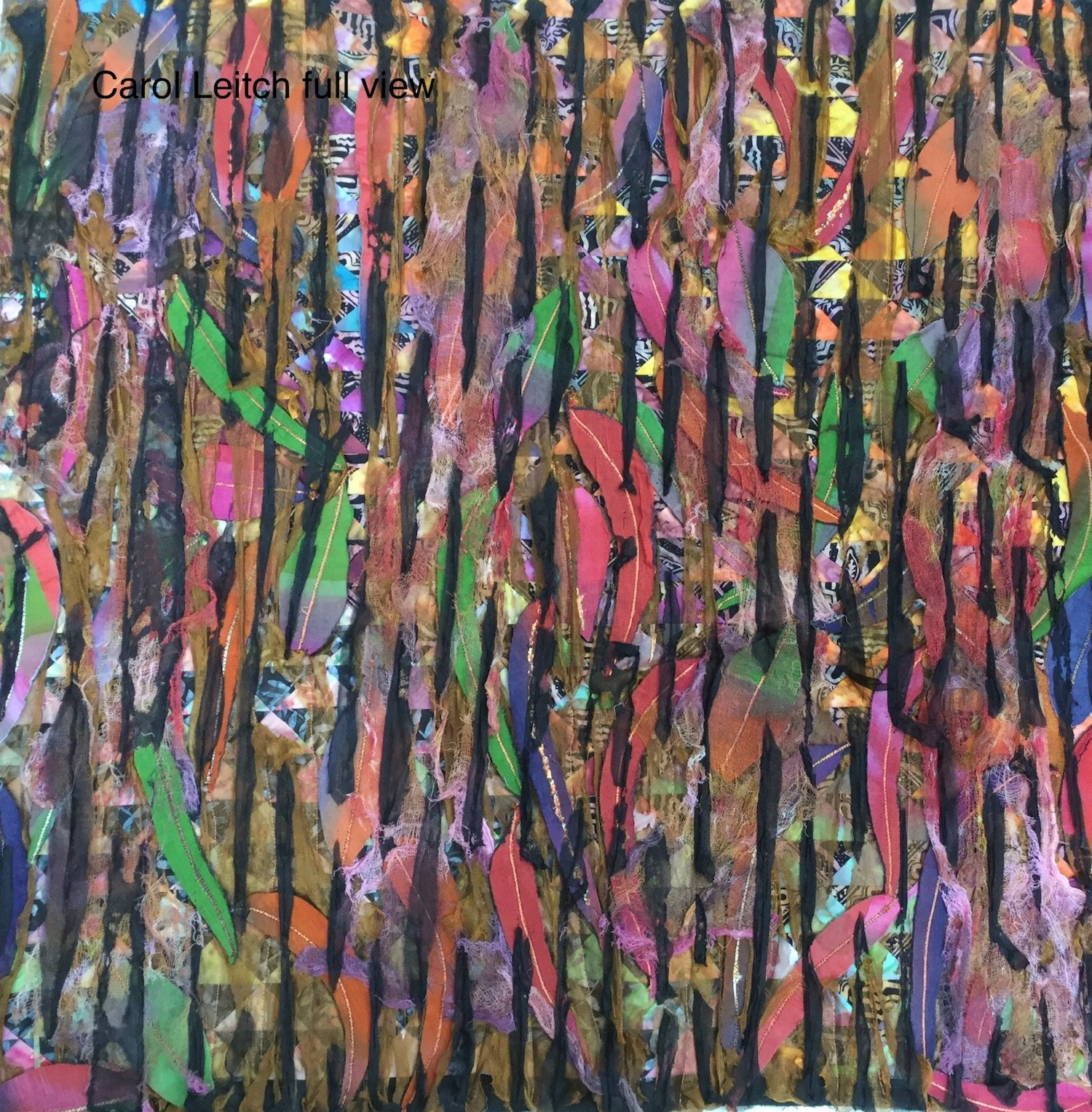
And Then the Fires Arrived
Carol Leitch, Umina Beach, New South Wales
Spring arrived and the drought extended its hold – creeks and rivers dried, there was no water. Then, with a rush, came the fires: anything and everything in its destructive path was destroyed.
Our beautiful wildlife has died in the millions, our plants from trees to grasses. What was once nourishment and shelter is gone. What was once green is gone.
Materials and techniques used: Hand-dyed fabric, felt leaf shapes, crystal organza which was burned and distorted with a heat gun. Hand-dyed gauze, ripped, torn and burnt. Background of machine pieced half square triangles commercial and hand dyed fabric.
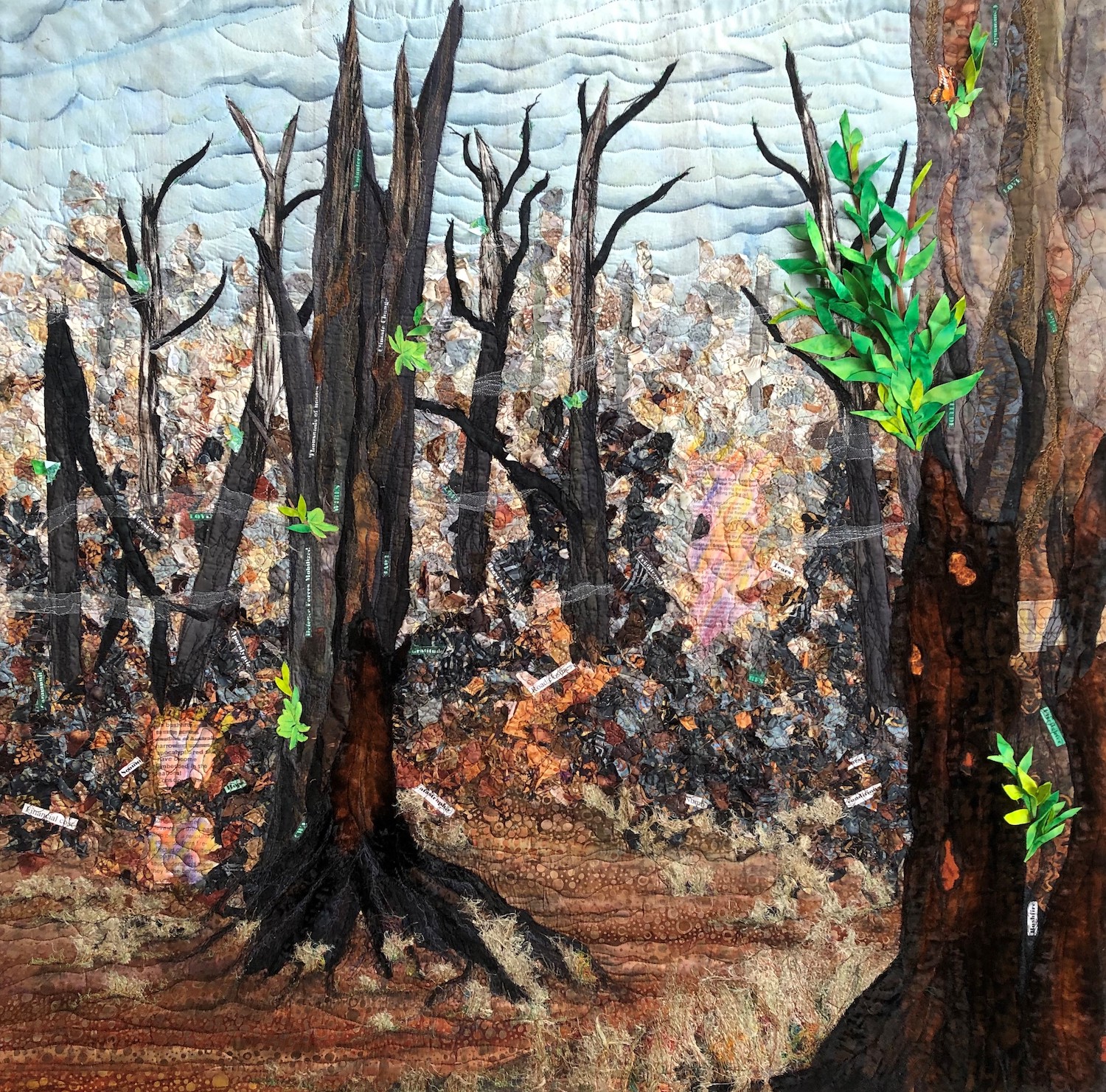
Regeneration
Tracie Stewart. Pimpama, Queensland
I started my piece for ‘Going Green’ in late December 2019, with the bushfires raging across Australia. The news was filled with devastation of the countryside and communities, loss of lives and government inaction. People’s lives were shattered into thousands of pieces. The thing that struck me most from the heartbreak and devastation, was the support and help that came from all over the world. Through something so heartbreaking, there was a renewal of community, of caring and connection – a regeneration of humanity. ‘Regeneration’ was inspired by this. The Australian bush will also regenerate, with green buds forming even now.
Materials and techniques used: Confetti applique, fusible applique, cotton batik fabrics, free motion quilting, thread painting; embellishments with taffeta, tulle, ribbon, silk fibres, words on printed fabric, burning manipulation of velvet, fabric dyeing, bleach dyeing, inktense painting, oil pastels.
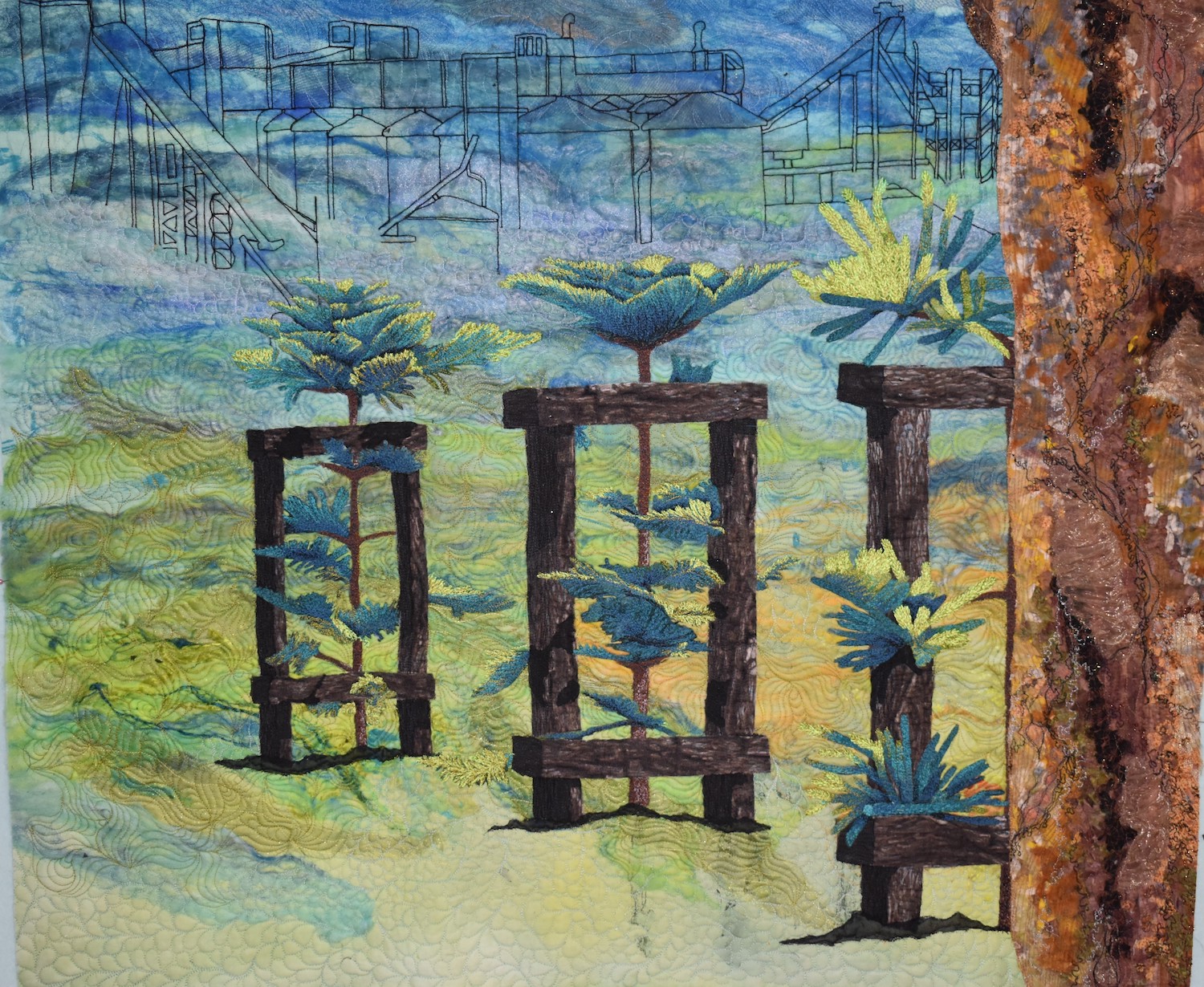
What If…
Di Tramontana, Picton, New South Wales
What if we could all meet the challenges of our everyday lives without the reliance on the environmentally costly manufacture of goods with built-in obsolescence! What if we could enjoy our coastline without the smelters and the factories marring the view! What if we could all tread lightly upon the country, the planet that we rely on and love! I have tried to imagine a section of coastline that is currently occupied by Port Kembla, without the solidity of the chimneys, warehouses and tanks. What if!
Materials and techniques used: Cotton fabric, organza, cotton-poly wadding, various machine threads raw edge applique by machine, thread painting and bobbin work, machine quilted.


